

Students, teachers and social networking. By Jordan Bienstock, CNN Student-teacher interaction is a constant part of the school day.
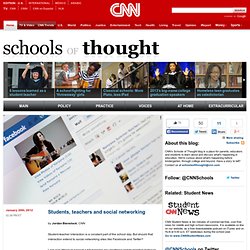
Schools and Online Social Networking. By Nancy Willard Most educators working with middle and high school students are aware of the explosive involvement of youth on social networking sites.

Few are prepared to deal with it. Internet safety expert Nancy Willard discusses the risks and benefits of such sites and offers schools a comprehensive approach to addressing student Internet access. Included: Advice for parents and teachers; online guidelines for students. Social Networking and Students: A Bad Mix? Is Social Networking Bad for You? Last Updated Jun 2, 2011 3:42 PM EDT Using part of your other 8 hours on social networking websites such as Facebook, LinkedIn, and Twitter can build your human capital, but social networking has a dark side that can stifle creativity and foster narrow-mindedness if you're not careful.

Once upon a time if you had different opinions, interests, or views from the norm, you were considered odd or maybe even weird. Then the Internet came along and changed all that. No matter how different you are, and no matter how strange your beliefs, you can find a million others just like you. On the surface, there's nothing wrong with this. Social Media's Impact on a Student’s S... Capital High School in Washington is like almost every other high school in the country in that it’s trying to strike the balance between giving students a fair freedom to use social networking devices, yet at the same time maintain attention and school customs throughout the day.
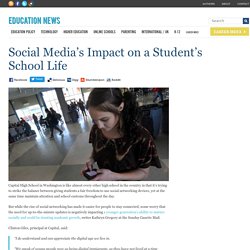
But while the rise of social networking has made it easier for people to stay connected, some worry that the need for up-to-the-minute updates is negatively impacting a younger generation’s ability to mature socially and could be stunting academic growth, writes Kathryn Gregory at the Sunday Gazette Mail. Clinton Giles, principal at Capital, said: “I do understand and can appreciate the digital age we live in. “We speak of young people now as being digital immigrants, as they have not lived at a time when there has not been all this technology.” However, he added: “For every benefit, I have seen at least one negative, especially here in the school setting. The 10 Best and Worst Ways Social Media Impacts Education.
Social networking communities are here to stay. Facebook has over 500 million users, while Twitter has over 200 million. That’s not even counting blogs or YouTube video blogs. There’s no doubt that students are actively engaged in online communities, but what kind of effects are these sites having and how can parents counteract the bad and bolster the positive? The Negative 1. 2. 3. 4. 5. The Positive 1. 2. 3. Social Networking’s Good and Bad Impacts on Kids. WASHINGTON—Social media present risks and benefits to children but parents who try to secretly monitor their kids’ activities online are wasting their time, according to a presentation at the 119th Annual Convention of the American Psychological Association.
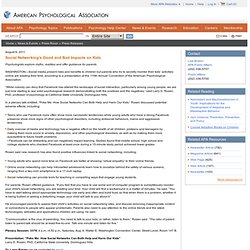
“While nobody can deny that Facebook has altered the landscape of social interaction, particularly among young people, we are just now starting to see solid psychological research demonstrating both the positives and the negatives,” said Larry D. Rosen, PhD, professor of psychology at California State University, Dominguez Hills. Ten ways schools are using social media effectively. Readers discuss how they use social networking in their schools, list helpful resources By Meris Stansbury, Online Editor Read more by Meris Stansbury October 21st, 2011 Many "families ‘like’ our Facebook page.
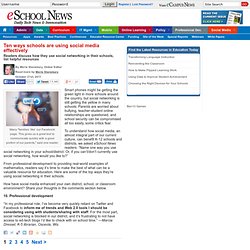
This gives us a great tool to communicate quickly with a good portion of our parents," said one reader. Social media find place in classroom. By Greg Toppo, USA TODAY Updated 7/25/2011 12:24 PM.

Policy Priorities:Can Social Media and School Policies be "Friends"?:Can Social Media and School Policies be "Friends"? Winter 2011 | Volume 17 | Number 4 Can Social Media and School Policies be "Friends"?

Between 2004 and 2009, the amount of time that kids ages 2 to 11 spent online increased by 63 percent, according to a Nielsen study. Driving these trends is increasing mobile access, which research from International Data Corp. predicts will eclipse wired access to the Internet by 2015. Leverage Social Media's Potential - Room for Debate. Social media is bad and has no place in education.
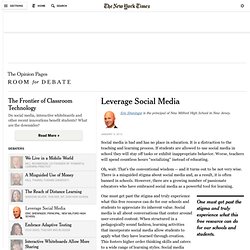
It is a distraction to the teaching and learning process. If students are allowed to use social media in school they will stay off tasks or exhibit inappropriate behavior. Worse, teachers will spend countless hours “socializing” instead of educating. Oh, wait. That's the conventional wisdom -- and it turns out to be not very wise. The Case For Social Media in Schools. A year after seventh grade teacher Elizabeth Delmatoff started a pilot social media program in her Portland, Oregon classroom, 20% of students school-wide were completing extra assignments for no credit, grades had gone up more than 50%, and chronic absenteeism was reduced by more than a third.
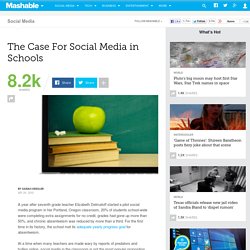
For the first time in its history, the school met its adequate yearly progress goal for absenteeism. At a time when many teachers are made wary by reports of predators and bullies online, social media in the classroom is not the most popular proposition. Teachers like Delmatoff, however, are embracing it rather than banning it. They argue that the educational benefits of social media far outweigh the risks, and they worry that schools are missing out on an opportunity to incorporate learning tools the students already know how to use. Fostering Media-Literate Students.
School Library Monthly/Volume XXVIII, Number 8/May-June 2012 Fostering Media-Literate Students by Kathy Fredrick Kathy Fredrick is the Director of Libraries and Instructional Technology for the Shaker Heights City Schools in Ohio. Should Your Library Have a Social Media Policy? Students Without Borders. A team of very smart teenagers has set out to discover ways that maggots might make the world a better place.
Two are from Loudoun County. Two live more than 9,000 miles away in Singapore. To many U.S. politicians, educators and business leaders, Singapore's students have become a symbol of the fierce competition the nation faces from high achievers in Asia. But these four students call themselves "international collaborators" and friends. Even as globalization has fed worries about whether U.S. students can keep up with the rest of the world, it also has spawned classroom connections across oceans. "When we talk on Facebook," Joanne Guidry, 17, one of the researchers at Loudoun's Academy of Science, said of her Singaporean peers, "you can't tell they are halfway around the world. " Ballou High School students in the District made a dance video to go-go music, and an Israeli school sent back a folk dance video. Older students tackle topics in more depth. Students Learn Cyber Skills At a No-Tech School - Teaching Now.